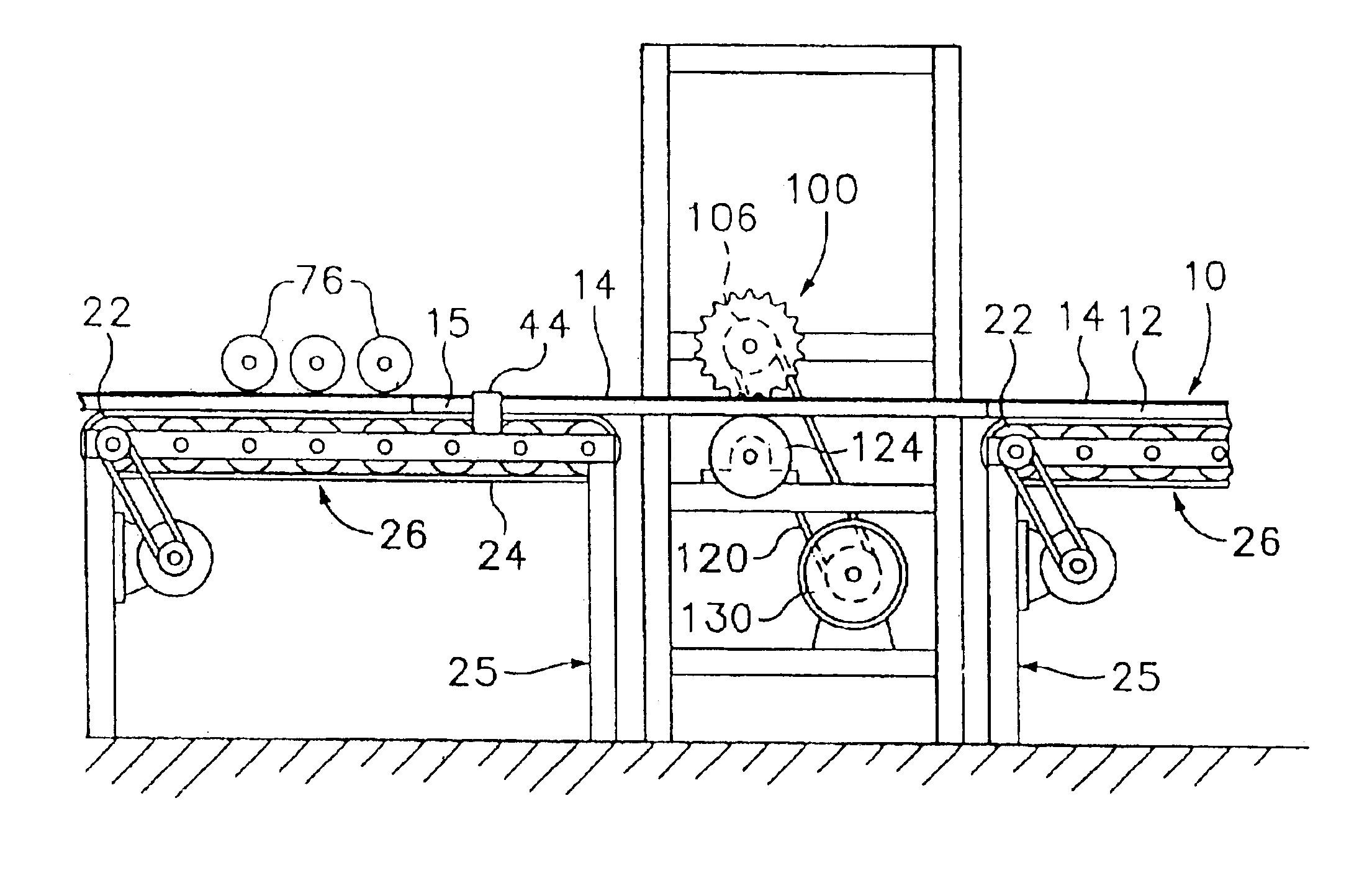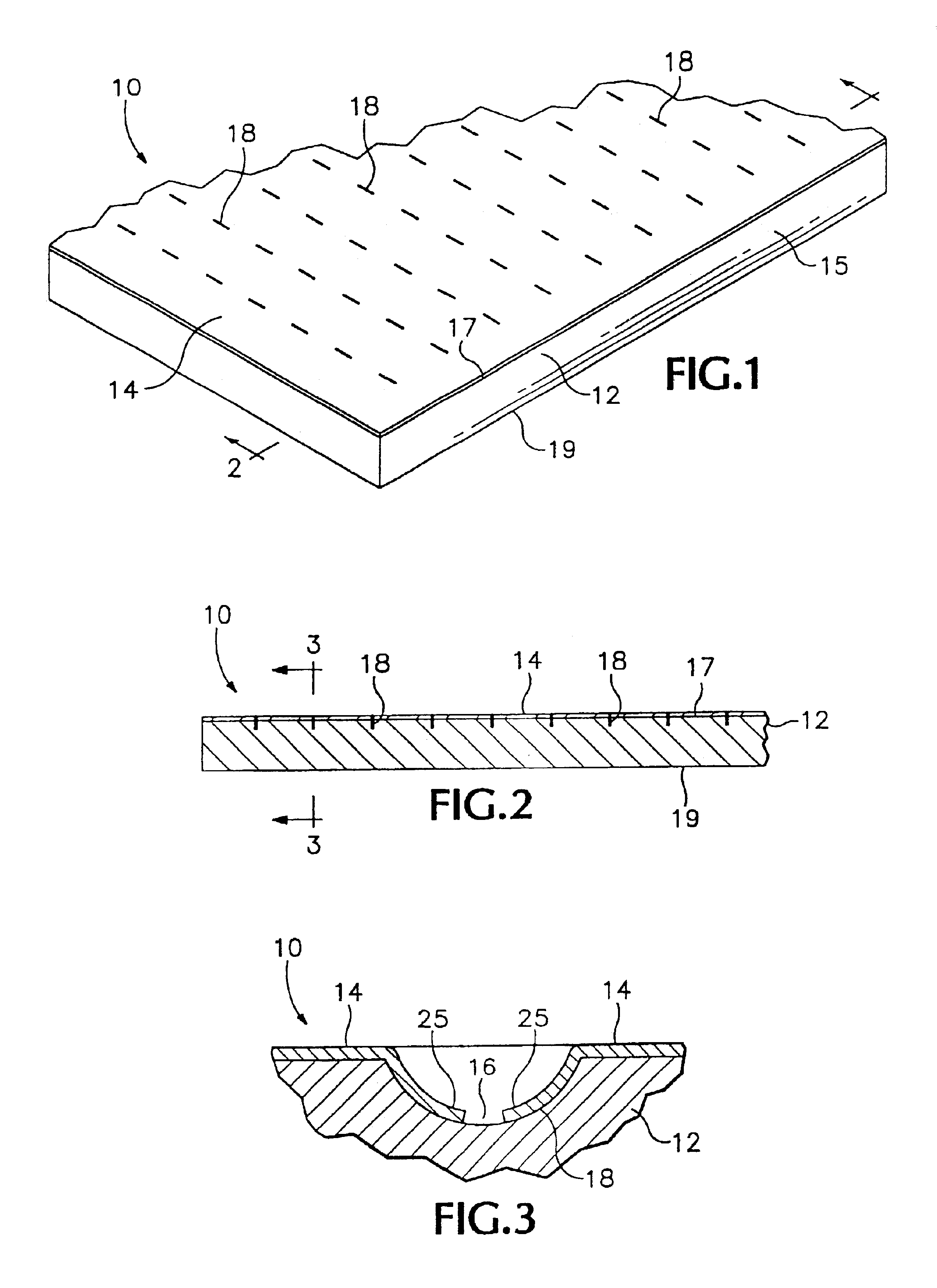[0011]US '814 and in US '495 can relate to a low
emissivity foil material which is adhered to a preformed underlying substrate in a secondary manufacturing operation to form a low
emissivity product having a high level of vapor permeability that enables trapped excess
moisture to be transported from the product to the surrounding
atmosphere. If a secondary manufacturing operation is employed in US '814 and / or US '495, substantial additional manufacturing equipment would be employed for use in thereafter applying a low emissivity radiant barrier material to a preformed underlying substrate. This results in (a) a considerable additional cost for the purchase and operation of the foil material application equipment, (b) significant additional
product formation time and associated higher manufacturing costs, and (c) reduced efficiencies involved in manufacturing a product which requires a post foil covering line which adheres the radiant barrier material to the performed underlying substrate.
[0012]Contrarily, the method of the present invention requires a substantial lesser amount of equipment and considerably fewer manufacturing steps in the in situ forming of a low emissivity foil material covered laminate substrate product. Employing the method of the present invention to form the subject radiant barrier material covered laminate substrate product results in (a) a considerable
cost savings relating to the costs of purchase and operation of the radiant barrier material application equipment, (b) a significant reduction in product formation time and a lowering of associated manufacturing costs, and (c) increased overall cost efficiencies due to the
elimination of the additional post radiant barrier covering
manufacturing line which are presently employed to adhere the radiant barrier material to the preformed underlying substrate. In addition, it is believed that the radiant barrier material covered laminate substrate product will exhibit an increased level of durability as compared to prior art non-laminate radiant barrier material covered products.
[0013]The method of this invention adheres a low emissivity radiant barrier material to an underlying lignocellulosic substrate within the primary manufacturing operation of the underlying lignocellulosic substrate. Thus, a radiant barrier covered substrate is formed by integrally joining the radiant barrier covering to a mat of lignocellulosic material during consolidation thereof with a first
adhesive bonding material to form an underlying substrate. The integral joining operation can, for example, be accomplished by bonding the radiant barrier covering to a lignocellulosic mat in a product formation press. This is typically accomplished using a second
adhesive bonding material for adhesion of the radiant barrier material to the lignocellulosic mat, and a first adhesive bonding material for consolidating the lignocellulosic mat to form a lignocellulosic substrate. More specifically, this invention is directed to a method whereby a low emissivity radiant barrier material is joined in situ to a mat of lignocellulosic particles using a second adhesive material to adhere the radiant barrier material to the lignocellulosic mat and a first adhesive bonding material to form an underlying substrate, an integral laminated radiant barrier covered lignocellulosic product being produced. Thus, a method of this invention is provided for producing an integral laminated lignocellulosic product which exhibits (a) a low level of emissivity and (b) a high level of
moisture vapor permeability, and which enables trapped excess moisture to be transported from the product to the surrounding
atmosphere While maintaining its effective radiant barrier properties.
[0021]A plurality of apertures are introduced into said radiant barrier material prior to and / or subsequent to the formation of said radiant barrier material covered mat of treated lignocellulosic material. If the plurality of apertures are to be introduced into said radiant barrier material prior to the formation of the radiant barrier material covered mat of treated-lignocellulosic material, it is usually accomplished by employing a pre-perforated radiant barrier material in the method of the present invention. If the plurality of apertures are to be introduced into said radiant barrier material subsequent to the formation of the radiant barrier material covered mat of treated lignocellulosic material, it is usually accomplished by introducing a plurality of apertures into the laminated radiant barrier material covered substrate thereby forming the permeable integral laminated product. In the case where the apertures are introduced into said radiant barrier material by pre-perforation thereof, for example, it may be a useful option to prevent blistering of the radiant barrier material which can sometimes result from excessive internal
gas pressure buildup during
hot pressing.
[0022]These apertures preferably extend substantially completely through both the radiant barrier material and the adhesive material thereby forming substantially completely open moisture vapor flow channels which create a high level of moisture vapor permeability through the radiant barrier material and the adhesive material thereby permitting a substantial amount of trapped excess moisture to pass from the underlying substrate into the surrounding
atmosphere to avoid unwanted degradation of the underlying substrate, while maintaining the low level of emissivity of the product. The apertures are formed by the step of perforating the radiant barrier material covered product. Preferably, the apertures are shaped in a substantially non-circular pattern. Furthermore, the amount of the radiant barrier material which is removed from the product can be minimized during forming of the apertures thereby maintaining the low level of emissivity of the product. In a preferred form of this invention, the plurality of apertures is introduced into the radiant barrier material by moving a portion of the radiant barrier material over the apertures, or within the confines of the apertures, for facilitating the low level of emissivity of the product. In another preferred form of this invention, the plurality of apertures are introduced into the radiant barrier material by moving a portion of the radiant barrier material into the confines of the apertures and maintaining the radiant barrier material portion therein without picking a substantial amount of the radiant barrier material portion from within the confines of the apertures for facilitating the low level of emissivity of the product. The product of the present invention is preferably formed by introducing a plurality of apertures into the radiant barrier material covered product so that the apertures extend substantially completely through the radiant barrier material, substantially completely through any intermediate layer such as paper or the like, as well as substantially completely through the adhesive material, thereby forming substantially completely open moisture vapor flow channels.
[0023]The product of this invention exhibits a combination of a high level of moisture vapor permeability, on the one hand, and on the other hand, excellent emissivity properties that emulate those of the prior art US '814 structures. Stated another way, a maximum amount of moisture can be released from the product of the present invention, while at the same time the desirable low emissivity effect of the
barrier layer material can be maintained. Thus, the products of the subject invention exhibit an optimum combination of low emissivity and a high level of moisture vapor permeability which causes excess moisture to be transported to the surrounding atmosphere from the product.
 Login to View More
Login to View More 


